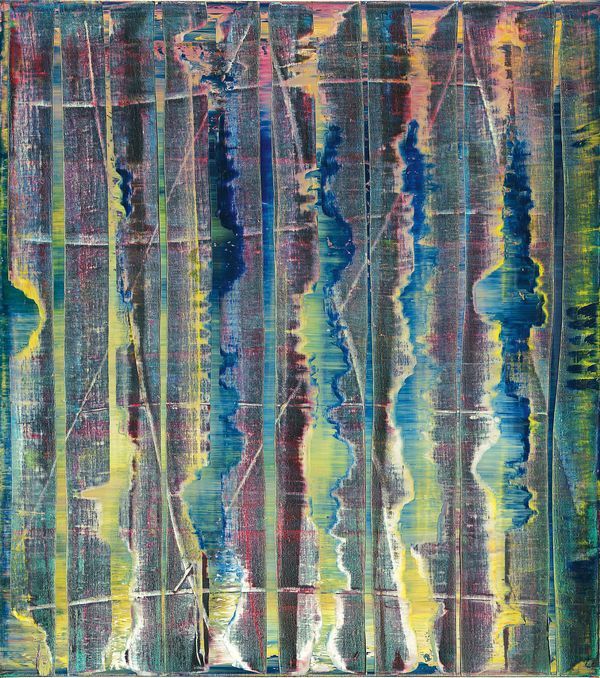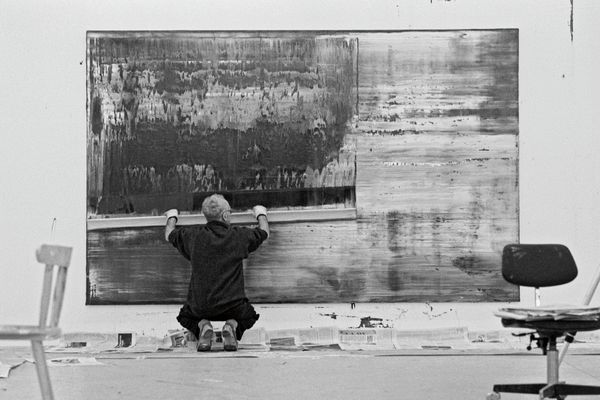Gerhard Richter Abstraktes Bild 776-1, 1992
Executed in 1992 following a breakthrough retrospective at London's Tate Modern the previous year, Abstraktes Bild 776-1 exemplifies the purest articulation of Richter's finest period of abstraction — "the culmination of a rigorous life-long investigation into the possibilities and limitations of painting," Ulrich Wilmes wrote in 2015. Using a squeegee, his trademark method, Richter created sinuous columns of radiant Prussian blue fused with vivid chartreuse that ripple down the canvas.
The glistening ribbons of color contrast with the more subdued violet background to form an eye-catching interplay of light and texture, tempting the viewer with some impenetrable reality hidden just beyond the painting's surface. In addition to the superimposed layers of rich bejewelled tones, Richter's left-to-right, stop-and-go motions of the squeegee stimulate the viewer's tactile senses by producing build-ups of paint, lining and rising above the hypnotic and aqueous columns like tides, giving form to yet another dimension of the work.
Presented in our inaugural sale of 20th Century & Contemporary Art & Design in Hong Kong, Abstraktes Bild is a key work realized during a climactic moment in Richter's career as the artist achieved unprecedented critical acclaim. Created the same year as his renowned four-part Bach suite (Moderna Museet, Stockholm), the monumental Abstraktes Bild belongs to one of Richter's most highly celebrated abstract cycles. Abstraktes Bild 809-3, for instance, prestigiously resides in the joint collection of the Tate Modern and the National Galleries of Scotland. Companion works are housed as collection highlights at the Hamburger Kunsthalle and the National Gallery of Art, Washington D.C.
[Richter's shimmering surfaces] look like the Aurora Borealis suspended above various red, orange, yellow, green, blue or violet planets.
The magnificent striations of Abstraktes Bild represent an innovative development in Richter's technique in the 1990s. Robert Storr notes in a 2002 exhibition catalogue for New York's Museum of Modern Art: The artist "has taken to flaying the painted skin of his canvases with a spatula in broad strokes or long, wavering stripes, leaving behind abraded, shimmering surfaces that at their most luminous look like the Aurora Borealis suspended above various red, orange, yellow, green, blue or violet planets." Offsetting the blended softness of the pigments, the sudden horizontal strips created by the hard edge of a palette knife cut across the canvas, imbuing the composition with a sense of unification and architectural structure.
This process is not one of addition, but rather of subtraction. Richter explains in a statement from 1992, "For about a year now, I have been unable to do anything in my painting but scrape off, pile on and then remove again. In this process, I don't actually reveal what was beneath. If I wanted to do that, I would have to think what to reveal (figurative pictures or signs or patterns); that is, pictures that might as well be produced direct. It would be something of a symbolic trick: bringing to light the lost, buried pictures, or something to that effect. The process of applying, destroying and layering serves only to achieve a more varied technical repertoire in picture-making."
[My paintings] should by all means be smarter than me…They have to be something that I no longer understand entirely.
—Gerhard Richter
Gerhard Richter in his studio
Richter acknowledges the irrepressible human urge to construct meaning and then deliberately frustrates this search as expressed by the squeegee, whose perforations induce the sensation of a long-lost figurative reality drifting just beyond the painting's tangible surface. Though the artist was uninterested in total randomness, Richter explained of all his paintings in 1990, "they should by all means, be smarter than me. I no longer have to be able to follow them completely. They have to be something that I no longer understand entirely. As long as I comprehend them theoretically, they are boring."
Abtraktes Bild therefore demonstrates Richter's preoccupation with this oscillation between phases of coincidence and periods of calculation. Richter elaborates, "And by not planning the result I hope to be able to realize rather a correctness and objectivity which any piece of nature always possesses."

